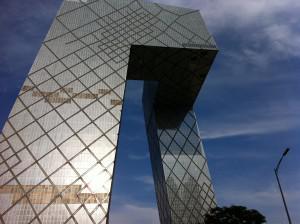 The famous, historic structures have not changed. As someone who visited Beijing in 2003, the Forbidden Palace and Tienanmen Square and the Great Wall were, of course, still there last week when I went back. But the rest of the city felt completely different.
The famous, historic structures have not changed. As someone who visited Beijing in 2003, the Forbidden Palace and Tienanmen Square and the Great Wall were, of course, still there last week when I went back. But the rest of the city felt completely different.
Let’s start with the bikes. There were massive pelotons swarming the streets in heart racing chaos ten years ago. Just venturing out sightseeing on a bicycle was enough to jolt you with adrenaline. Now, right as bicycle sharing programs across the world are taking off, Beijing is noticeably lacking the bicycle crowds of the past. Sure, it still has the largest bike sharing program in the world, but the car is now king and the streets are a stagnant river of 4 wheel vehicles much of the day, everyday. This is even with cars restricted by odd and even numbered license plates as to which day they can legally use the roads. The subway system is also much more extensive and was packed on the Sunday night that I rode on it. But in general driving seems the preferred method of transport. The air has paid for this change, though on the days I was there rain from major storms a few days before and favorable winds kept the skies fairly blue and the eyes and lungs free from burning. The city has been rapidly built up, and feels like any other city in the developed world, even though the country as a whole is still developing.
The Olympics surely made the city change. In addition to Olympic structures like the Watercube and Bird’s Nest Olympic Stadium, the city made huge upgrades in infrastructure. It also cleaned up the streets and tore down many of the old, brick houses with dirt floors that made up a large portion of Beijing’s side streets. There are still some of those areas but they are hidden. In their place, forests of skyscrapers packed with offices and apartments dominate the city center and ring the suburbs. There is a glittering shopping avenue akin to Ginza in Tokyo or Fifth Avenue in New York, and while the prices are lower and the brands not quite as ritzy, for all intents and purposes the same obsession with “things” is alive and well.
It is impossible to say that these changes are not good for China. Incomes have risen, people are living more comfortably, and poverty has decreased. Now Beijing and the hundreds of booming cities across the country have to deal with the side-effects of a headlong rush toward development. In the name of progress, resources are being rapidly exploited not only in China but across the world to feed the energy needs of over 1 billion people reaching for modern lifestyles and conveniences. Pollution is rampant, and so is waste from an ever more pre-packaged, use and discard mentality.
It is easy to be pessimistic in terms of how a world of 7 billion people, half of whom are rapidly moving to consume in ways previously reserved to a relatively small part of the human population, can balance environmental and economic needs. But the trip to Beijing had a rather different impact on my view toward that conundrum. With the Internet linking all corners of the globe, ideas, technologies, and movements spread faster than ever before. True, the central government in China is holding on to restrictions in terms of what information enters the country. China, in this regard, is a contradiction. But still, people are collaborating and sharing on a scale never previously seen. So long as we recognize the need for changes to our lifestyle to make economic and environmental sustainability a priority, there is no reason why we can’t have a rapid shift to the behaviors and technologies that will set us on a more sustainable path.
[Image by author]

